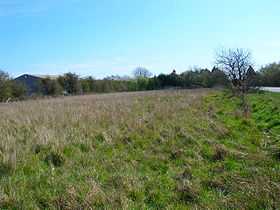Rhee Wall

The Rhee Wall is a former watercourse in Romney Marsh in Kent. It is 7.5 miles long and runs from Appledore, on the north-western edge of Romney Marsh, south-east through Snargate, Brenzett and Old Romney, to New Romney near the coast. The Rhee Wall forms a boundary between Romney Marsh proper, to the north-east, and Walland Marsh to the south-west.[1][2]
It consists of two parallel earth banks, from 50 to 100 metres apart, the ground between being raised above the marsh on either side.[2]
It was built in the 13th century; a watercourse was constructed from Appledore to Old Romney, which was extended in 1258 to New Romney. The purpose was to wash away silt from the harbour at New Romney; there were sluices to control the flow at Appledore, Snargate and New Romney. However, the silt at New Romney continued to accumulate. After the South England flood of February 1287, the harbour at New Romney was completely blocked, and the River Rother, which had flowed into the sea here, was diverted away. The Rhee Wall has not contained water since medieval times.[2][3][4]
It has since been used as a dry causeway above the marsh. In the present day, the B2080 road follows the route of the Rhee Wall from Appledore south-east to Brenzett; the route continues south-east to New Romney as part of the A259 road.[3]
References
- ↑ One-inch map of Great Britain: Sheet 184, Hastings. Ordnance Survey, 1969.
- ↑ 2.0 2.1 2.2 Rhee Wall Rye Castle Museum, accessed 27 Oct 2014.
- ↑ 3.0 3.1 The Rhee Wall Rother Country, by Bob Chantler, accessed 27 Oct 2014.
- ↑ History of Romney Marsh The Romney Marsh.net, accessed 27 Oct 2014.
Coordinates: 51°0.1841′N 0°51.9534′E / 51.0030683°N 0.8658900°E